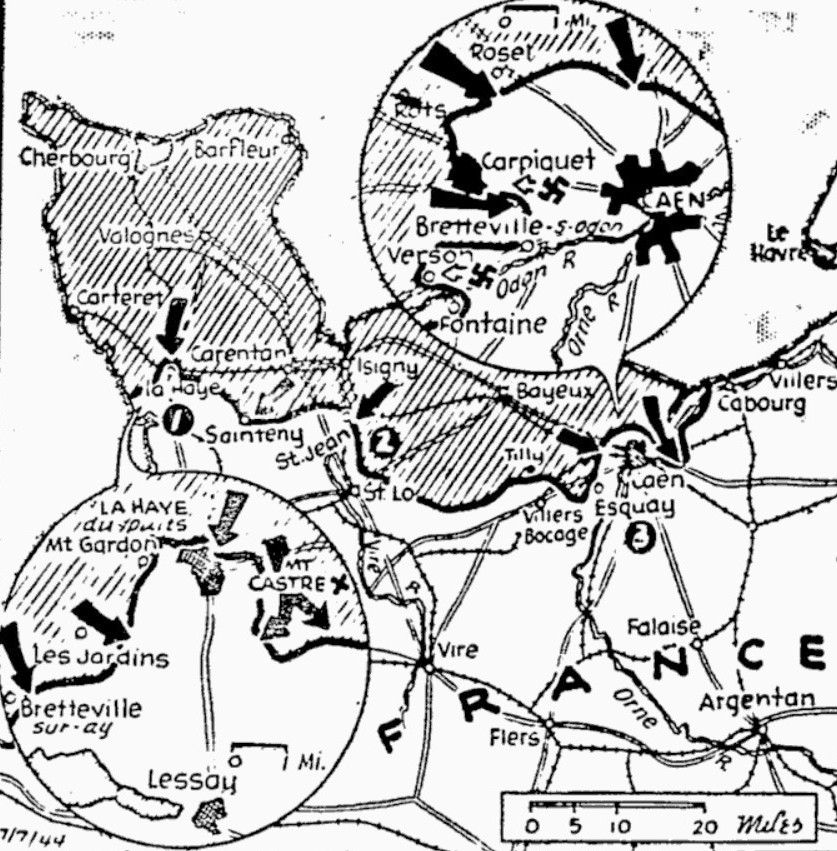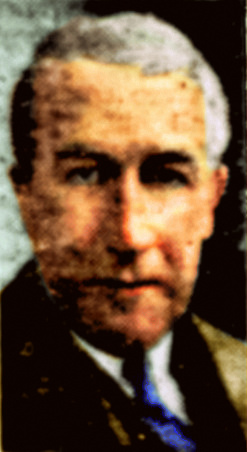The Pittsburgh Press (July 8, 1944)
Americans also lunge forward in center of Normandy front
By Virgil Pinkley, United Press staff writer
SHAEF, London, England –
Gen. Sir Bernard L. Montgomery hurled the full weight of the British 2nd Army at Caen along a seven-mile assault arc today and by evening his shock troops had advanced an average of one mile through at least seven outlying villages to within one-and-a-half miles of the heart of the city.
Front dispatches reported even more impressive gains in the new offensive aimed at blasting open the 120-mile road westward to Paris. They said advanced elements were within half a mile of the center of Caen and named two villages captured in addition to the seven announced at headquarters plus parts of two more.
Reports reached headquarters that the Germans were moving big guns and armor south and southeast of Caen and vehicular traffic was heavy along the only two of 14 roads radiating from the city which were still in Nazi hands.
The headquarters report of German movements, not amplified, appeared to hit at a Nazi flight from Caen under the drubbing impact of Gen. Montgomery’s full dress offensive to escape the threat of entrapment in the partially encircled city.
Zero hour at 4:20
Zero hour was 4:20 a.m. today. British and Canadian troops went over the top after the heaviest artillery bombardment of the Normandy campaign had softened the German positions in and around the great inland port of Caen. This evening, a headquarters spokesman said the day’s advances were “highly satisfactory.”
Officially reported overrun in the converging assault on Caen were the villages of Gruchy, Buron, Saint-Contest and Épron, while parts of Lébisey and Hérouville were in Allied hands. Other reports added Galamanche and La Bijude to the list of captured villages.
Headquarters spokesmen also announced the capture, in addition to the tight little knot of villages in suburban Caen, of Malon, four miles northwest of the center of the town; Bitot, three miles north-northwest, and Colombelles on the Caen Canal, two-and-three-quarters northeast.
Capture Saint-Jean
U.S. forces driving forward on the central front in Normandy captured the town of Saint-Jean-de-Daye, eight miles north of Saint-Lô, and the nearby village of Goucherie.
Driving on beyond Saint-Jean, U.S. forces who smashed across the Vire River joined another column pushing down from the north, and both forces are now well over six miles southwestward of Isigny, the hinge position at the southwest corner of the Seine Bay.
The Americans probably hold an important crossroad south og Saint-Jean, headquarters sources reported in describing the expansion of the bridgehead west of the Vire.
Seize high ground
Farther westward other U.S. forces seized all high ground southwest and southeast of La Haye-du-Puits, sealing the doom of that western anchor of the German defense line.
Making a small but important advance southwest of La Haye, the Americans reached the village of Lemont. A like advance in the Mont-Castre forest carried almost to the village of Gerville.
Headquarters reports indicated that Caen was under a grave threat from the north. British units battering through the thick-set defenses had advanced up to a mile-and-a-half to a point a quarter-mile below the Couvrelles–Cher rail station, about halfway from the takeoff line to the center of the city.
Canadians gain
At the same time, Canadian troops were attacking from the northwest with like success.
A commentator said that if the Germans resist strongly the battle of Caen might conceivably prove one of the decisive battles of the war.
Striking in the wake of a 2,300-ton aerial attack and one of the heaviest artillery barrages of the Normandy campaign, British and Canadian troops plunged into the burning suburbs of Caen on a broad front and began a showdown battle that may determine the length of the war in the west.
Battle hand-to-hand
Ronald Clark, United Press staff writer, reported from the front that fierce hand-to-hand fighting was raging at key points deep inside the enemy’s so-called Byron Line of fortified villages on the approaches to Caen, the Germans’ eastern anchor athwart the Cherbourg–Paris highway and railroad.
Mr. Clark said:
Progress was made in the first stages of the attack and a number of the enemy were wiped out. Our troops are sure and confident of the results.
Face 1,400 tanks
Gen. Montgomery unleased his climatic offensive against the strongest-held sector of the whole Normandy front, defended by nearly seven crack enemy panzer divisions, 1,400 tanks and 84,000 men at full strength.
But Gen. Montgomery never makes a full-scale effort unless he believes he has a better-than-even chance of success, and he has had nearly five weeks in which to build up his forces.
More than 450 huge four-engined Halifax and Lancaster bombers of the RAF struck the first blow of the long-expected offensive at dusk last night when they roared over the frontlines
Like at El Alamein
Flame and smoke still belched from Caen and its northern defenses early today as massed British artillery began a bombardment reminiscent of the mighty barrages that cleared the way for Gen. Montgomery’s breakthroughs at El Alamein and the Mareth Line in Africa.
United Press staff writer Samuel D. Hales reported from Normandy:
No cannonading like that during the first half-hour had been heard on this front since the assault on the beaches D-Day.
The barrage shifted to provide a creeping curtain of protective shells bursting a few hundred yards in advance as the infantry rose from their trenches and moved toward the German lines with Tommy guns, bayonets and grenades.
Dock area empty
Lt. Gen. Sir Miles C. Dempsey’s 2nd Army held positions two to four miles east, north, west and southwest of Caen, but the disclosure that the mighty RAF bomber force struck principally north of the town indicated the main weight of the attack was also concentrated there.
British patrols thrust into the dock area of Caen yesterday and found it empty of Germans, but Allied authorities were cautious about interpreting this as a sign that the enemy has decided to pull out of the town without a finish fight.
Nevertheless, German broadcasts belittling the importance of Caen and contending that the Allies, if they capture the town, will find only ruins was taken as a sign that they will not make a costly or protracted defense before they fall back to less exposed defenses.
The new offensive put the Allies on the march along the entire 111-mile front in Normandy.
Powerful U.S. outflanking columns were approaching the enemy’s only escape road south of La Haye, however, and the garrison soon must choose between abandoning the town or encirclement.
Advancing along the 363-foot wooded Mont-Castre plateau on the eastern flank, one column reached a point two-and-a-quarter miles southeast of La Haye, while the western force seized the village of Biémont, two-and-a-half miles southwest of La Haye.
U.S. columns converging on Périers, nine miles southeast of La Haye and 11 miles southwest of Carentan, advanced to points only five-and-a-half miles away from the north and northeast.
Gain high ground
One, advancing along the Carentan–Périers road, captured high ground 800 yards east of Sainteny, while the other pushed down the Saint-Jores road to the village of Le Plessis, two miles south of Saint-Jores.
The Americans were encountering increased German artillery and mortar fire, as well as extensive minefields and inundations in their advances along the two highways but pressed on without pause.

